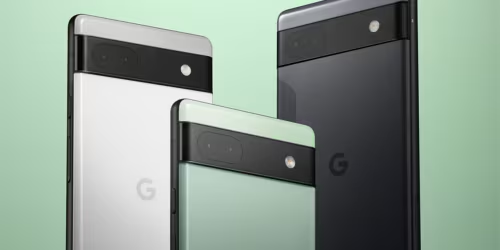Following the major overhaul introduced with the Pixel 6 and 6 Pro, Google brought its new vision to the masses in July 2022 with the Google Pixel 6a. This phone wasn’t just an incremental update; it represented bringing the core intelligence and performance of the flagship line, powered by the custom Google Tensor chip, into the incredibly popular and budget-friendly “a” series.
Design: Pixel 6 Looks, Compact Form

The Pixel 6a immediately stood out from previous ‘a’ series models by adopting the distinctive design language of its flagship siblings:
- Camera Bar Style: It featured the prominent horizontal Camera Bar across the back, instantly marking it as part of the Pixel 6 generation.
- Materials: While visually similar, it used a “thermoformed composite” (plastic) back instead of the glass found on the Pixel 6/6 Pro, paired with a sturdy alloy frame. It came in three colors: Chalk, Charcoal, and Sage.
- Compact Size: With a 6.1-inch display, it was noticeably more compact than the Pixel 6 and even slightly smaller than the Pixel 5a, making it a great option for those preferring easier one-handed use.
- In-Display Sensor: It moved to an under-display optical fingerprint sensor, like the Pixel 6 series.
- Durability: Maintained the excellent IP67 water and dust resistance rating introduced with the Pixel 5a.
- Headphone Jack Removed: In a move that disappointed some long-time ‘a’ series fans, the Pixel 6a was the first ‘a’ series phone to omit the 3.5mm headphone jack.
Hardware: The Power of Tensor
The headline feature was undoubtedly the inclusion of Google’s custom chip:
- Google Tensor (Gen 1): The Pixel 6a was equipped with the exact same powerful Tensor SoC found in the flagship Pixel 6 and 6 Pro. This brought flagship-level performance, especially for AI and machine learning tasks, to the mid-range market – a significant advantage over competitors using standard mid-range chips.
- RAM & Storage: It included 6GB of fast LPDDR5 RAM and 128GB of speedy UFS 3.1 storage (the only configuration offered).
- Display: Featured a vibrant 6.1-inch OLED display (FHD+ resolution). However, one key cost-saving measure was the refresh rate, which was locked at 60Hz, lacking the 90Hz or 120Hz smoothness found on the Pixel 6/6 Pro and some mid-range competitors.
- Battery: Housed a respectable 4410mAh battery, offering solid all-day battery life, supported by 18W wired charging (no wireless charging).
- Security: Benefited from the integrated Titan M2 security chip within the Tensor SoC.
Cameras: Proven Sensor, Tensor Magic
Google made an interesting choice with the camera hardware, pairing a familiar sensor with the new chip’s capabilities:
- Main Sensor: Instead of the 50MP sensor from the Pixel 6, the 6a used the tried-and-true 12.2MP Sony IMX363 sensor – the same one used reliably since the Pixel 3a/4a/5a generation. While older, Google’s software processing, now supercharged by Tensor, ensured it still produced fantastic photos.
- Ultrawide: It shared the same 12MP ultrawide sensor as the Pixel 6 and 6 Pro, providing consistency across the lineup for wider shots.
- Front Camera: A standard 8MP selfie camera.
- AI-Powered Features: Thanks to Tensor, the 6a gained access to flagship features previously unavailable on the ‘a’ series, including:
- Magic Eraser: Easily remove distractions from photos.
- Real Tone: More accurate and flattering skin tone representation.
- Face Unblur: Sharpen faces blurred by motion.
- Night Sight, Portrait Mode, and Super Res Zoom continued to deliver excellent results.
Software: Material You and Long Support
Launching with Android 12 and the dynamic Material You theming, the Pixel 6a offered the latest Google software experience. It also came with a strong update commitment: 3 years of Android OS updates (until July 2025) and 5 years of security updates (until July 2027).
Reception and Legacy: Flagship Brains, Mid-Range Price
The Pixel 6a was highly praised upon release, largely seen as delivering exceptional value for its $449 price tag. Bringing the powerful Tensor chip to the mid-range offered performance and AI features previously reserved for flagships. The camera, despite the older main sensor, continued to impress thanks to Google’s software magic, and the compact design was a plus for many.
The main points of criticism were the 60Hz display refresh rate (when competitors were offering faster screens) and the removal of the headphone jack, a staple of previous ‘a’ series phones. Despite these trade-offs, the Pixel 6a successfully brought the modern Pixel experience – powerful AI, unique features, and great photography – to a more accessible price point, continuing the ‘a’ series legacy of outstanding value.
